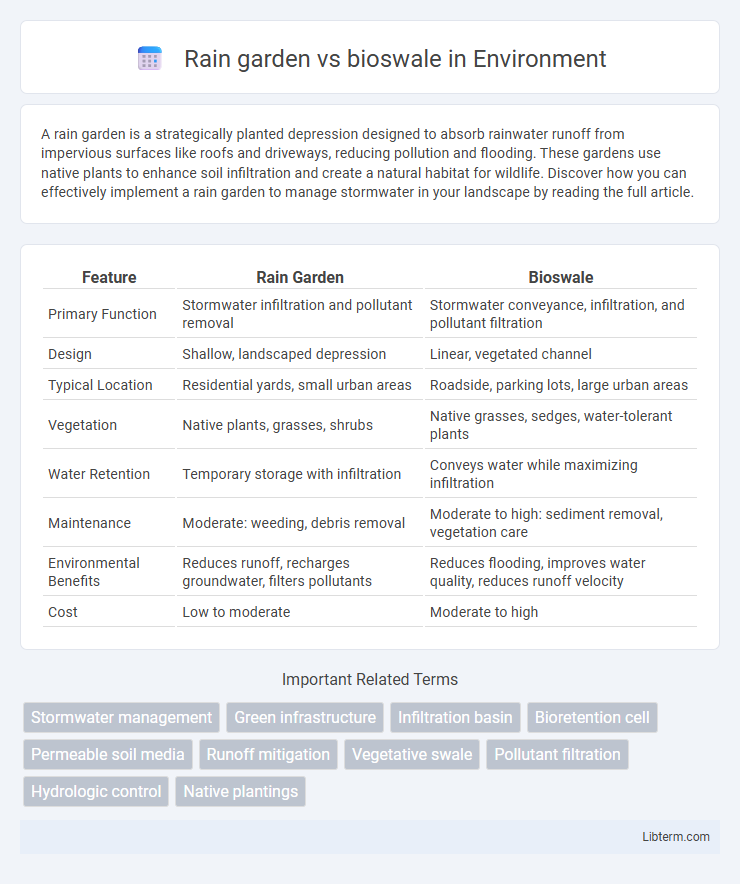A rain garden is a strategically planted depression designed to absorb rainwater runoff from impervious surfaces like roofs and driveways, reducing pollution and flooding. These gardens use native plants to enhance soil infiltration and create a natural habitat for wildlife. Discover how you can effectively implement a rain garden to manage stormwater in your landscape by reading the full article.
Table of Comparison
| Feature | Rain Garden | Bioswale |
|---|---|---|
| Primary Function | Stormwater infiltration and pollutant removal | Stormwater conveyance, infiltration, and pollutant filtration |
| Design | Shallow, landscaped depression | Linear, vegetated channel |
| Typical Location | Residential yards, small urban areas | Roadside, parking lots, large urban areas |
| Vegetation | Native plants, grasses, shrubs | Native grasses, sedges, water-tolerant plants |
| Water Retention | Temporary storage with infiltration | Conveys water while maximizing infiltration |
| Maintenance | Moderate: weeding, debris removal | Moderate to high: sediment removal, vegetation care |
| Environmental Benefits | Reduces runoff, recharges groundwater, filters pollutants | Reduces flooding, improves water quality, reduces runoff velocity |
| Cost | Low to moderate | Moderate to high |
Introduction to Rain Gardens and Bioswales
Rain gardens and bioswales are sustainable stormwater management systems designed to reduce runoff and improve water quality by promoting infiltration and filtration. Rain gardens are shallow, landscaped depressions planted with native vegetation that capture and absorb rainwater from rooftops, streets, and driveways. Bioswales, typically linear and vegetated, are engineered channels that convey and treat stormwater by slowing flow and filtering pollutants through soil and plants.
Key Differences Between Rain Gardens and Bioswales
Rain gardens are shallow, landscaped depressions designed to capture and infiltrate stormwater runoff, primarily using native plants and amended soils to enhance groundwater recharge. Bioswales are linear, vegetated channels engineered to convey, treat, and slow stormwater, incorporating features like sediment traps and check dams to improve water quality before discharge. Unlike rain gardens, which act as retention systems, bioswales function as conveyance mechanisms that also provide filtration and pollutant removal within stormwater management systems.
How Rain Gardens Work
Rain gardens function by capturing and infiltrating stormwater runoff through layers of soil and specialized plants, reducing surface water and filtering pollutants naturally. Designed with engineered soil media and native vegetation, they slow down water flow, encourage absorption, and enhance groundwater recharge. Unlike bioswales that often transport large volumes of water, rain gardens prioritize localized water retention and habitat creation, making them efficient for managing urban runoff.
How Bioswales Function
Bioswales function by channeling stormwater runoff through engineered, vegetated swales that slow water flow, promote infiltration, and filter pollutants through soil and plant roots. These designs leverage permeable soils and dense vegetation to capture sediments, heavy metals, and nutrients before water enters storm drains or natural waterways. Unlike rain gardens, bioswales often feature linear shapes that handle larger volumes of runoff along streets or parking lots, enhancing urban water management.
Design Elements of Rain Gardens
Rain gardens incorporate shallow depressions, native plants, and engineered soil mixtures to enhance infiltration and pollutant removal, distinguishing them from bioswales which emphasize elongated conveyance channels with dense vegetation. Their design elements prioritize capturing stormwater runoff close to its source, using layered soil media and mulch to support plant health and maximize water absorption. Rain gardens typically feature contouring that directs water flow while preventing erosion, optimizing both aesthetic appeal and ecological functionality.
Design Components of Bioswales
Bioswales incorporate shallow, linear channels with gently sloped sides designed to slow and filter stormwater runoff through vegetation, engineered soil layers, and underlying gravel media. Key design components include check dams to reduce flow velocity, native plants selected for pollutant uptake and erosion control, and an infiltration zone to promote groundwater recharge. These features differentiate bioswales from rain gardens by emphasizing directed conveyance and enhanced filtration along drainage pathways.
Environmental Benefits: Rain Gardens vs Bioswales
Rain gardens and bioswales both improve stormwater management by filtering pollutants and reducing runoff, enhancing groundwater recharge, and mitigating urban flooding. Rain gardens provide localized infiltration through native plants and engineered soil layers, promoting biodiversity and habitat creation, while bioswales channel water efficiently along vegetated pathways, capturing debris and sediments before they reach water bodies. Both systems reduce erosion and improve water quality, but bioswales are typically designed for larger-scale conveyance, whereas rain gardens excel in small-scale infiltration and aesthetic integration.
Maintenance Requirements for Each System
Rain gardens require regular maintenance including weeding, mulching, and seasonal plant replacement to ensure proper water infiltration and avoid clogging. Bioswales demand more frequent sediment removal and vegetation trimming due to their design for larger stormwater volumes, which helps maintain flow capacity and prevents erosion. Both systems benefit from inspections after heavy storms to identify blockages and structural damage.
Ideal Applications and Site Selection
Rain gardens are ideal for residential or small-scale urban settings with moderate slopes, permeable soils, and space limitations, effectively managing stormwater close to the source. Bioswales suit larger landscapes such as commercial sites, parking lots, or highways, designed to handle higher volumes of runoff and longer flow paths while promoting filtration and conveyance. Site selection for rain gardens emphasizes gentle slopes and well-drained soils to prevent standing water, whereas bioswales require engineered soils and graded channels to optimize infiltration and slow runoff velocity.
Choosing the Right Solution for Stormwater Management
Rain gardens and bioswales both effectively manage stormwater by promoting infiltration and reducing runoff, but selection depends on site conditions and goals. Rain gardens suit smaller areas with minimal slope, offering aesthetic landscaping and pollutant filtration, while bioswales accommodate larger flows along streets or parking lots with linear designs that convey and treat runoff. Evaluating soil permeability, space availability, and maintenance capacity guides choosing the optimal green infrastructure for sustainable stormwater management.
Rain garden Infographic

 libterm.com
libterm.com